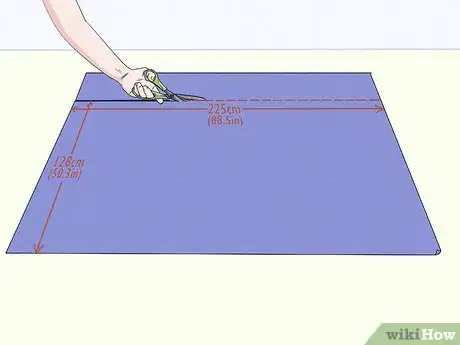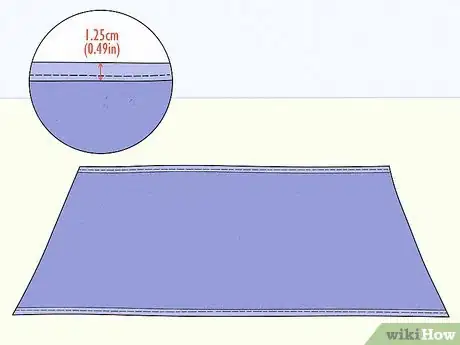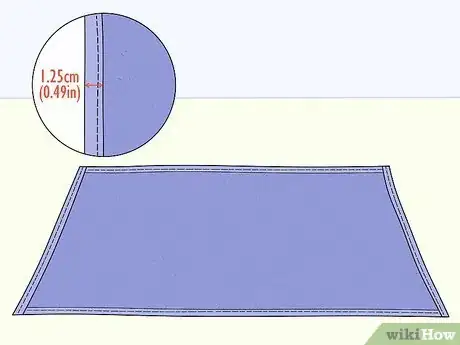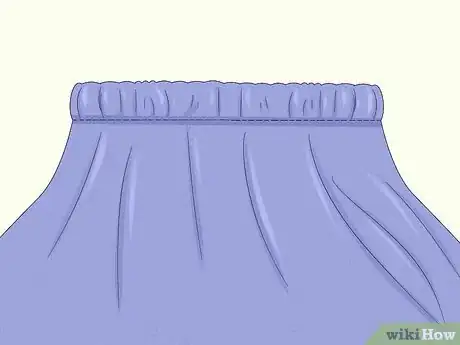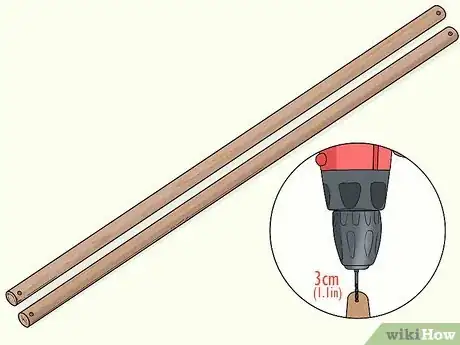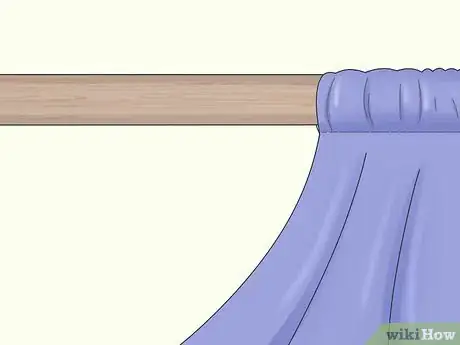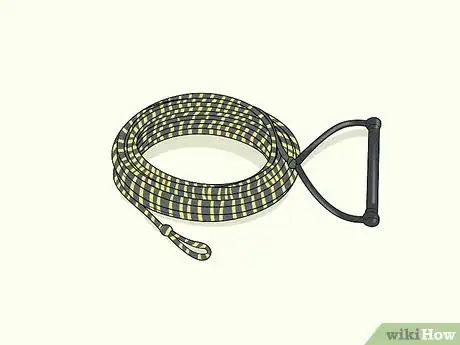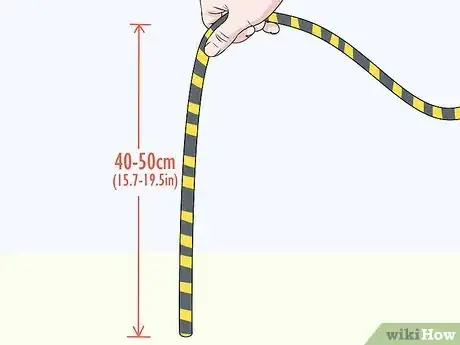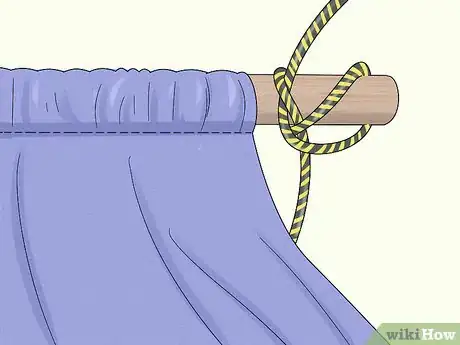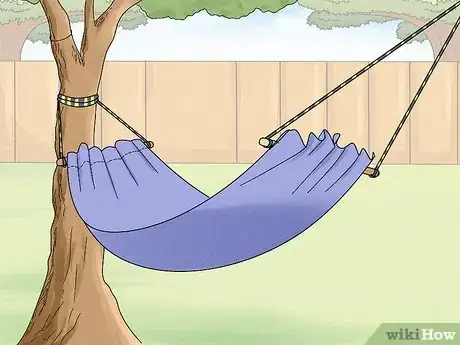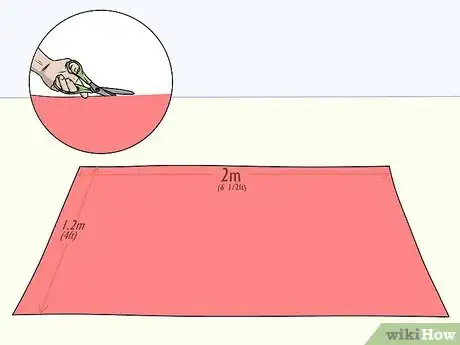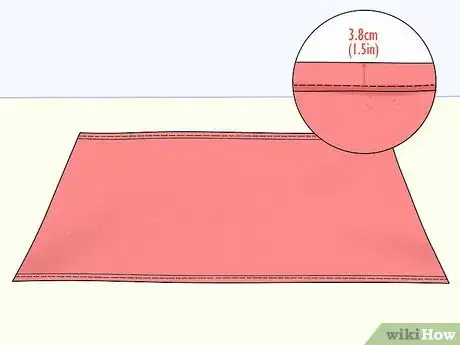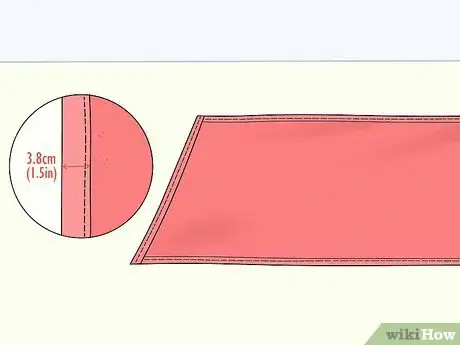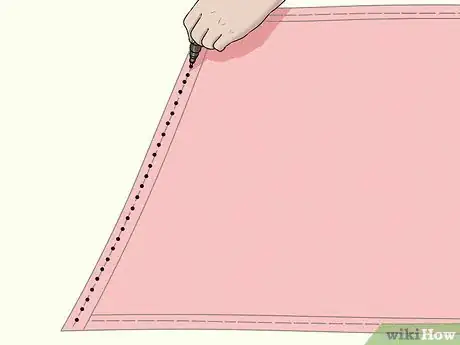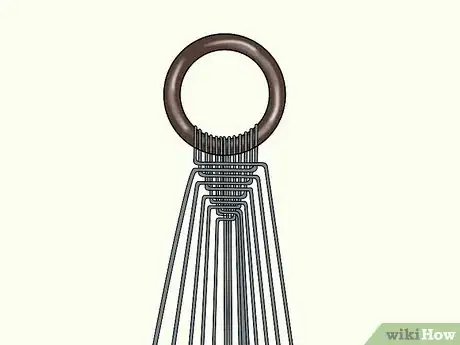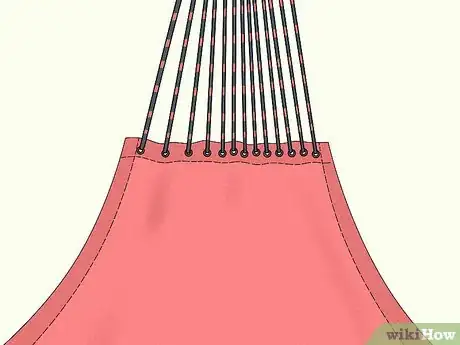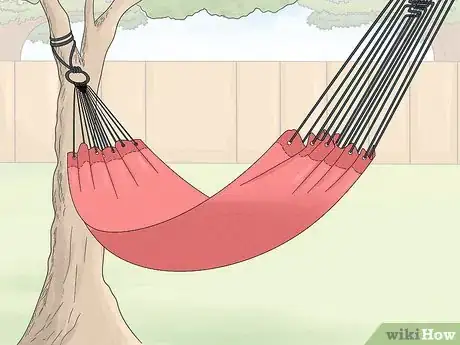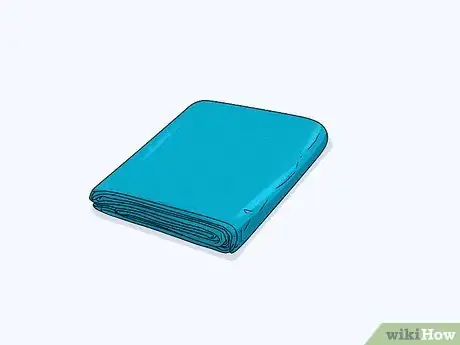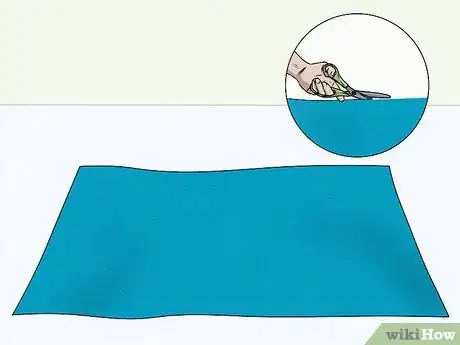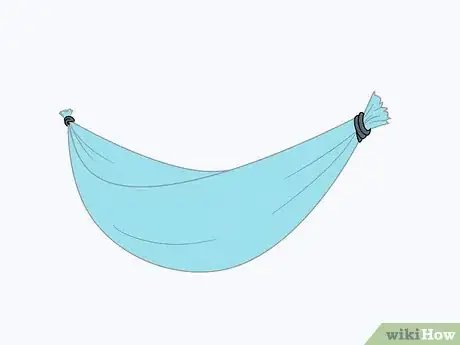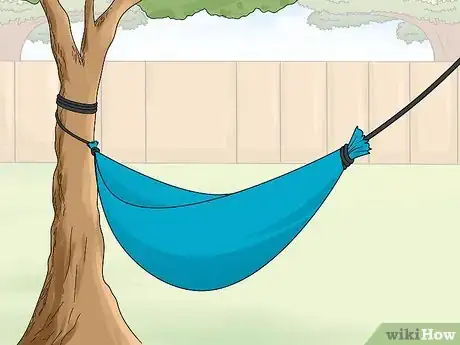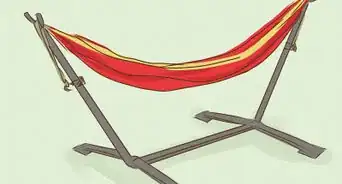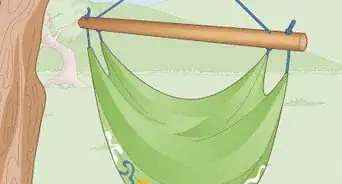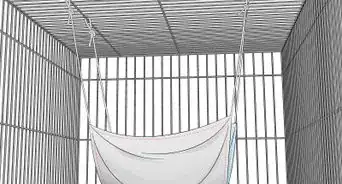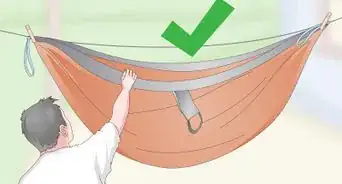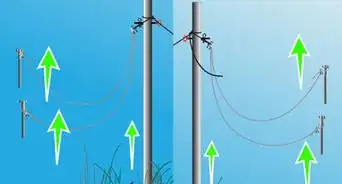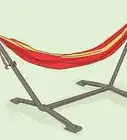This article was co-authored by Josh Goldbach and by wikiHow staff writer, Hunter Rising. Josh Goldbach is an Outdoor Education Expert and the Executive Director of Bold Earth Adventures. Bold Earth leads adventure travel camps for teenagers all over the world. With almost 15 years of experience, Josh specializes in outdoor adventure trips for teens both in the United States and internationally. Josh earned his B.A. in Psychology from Eckerd College in St. Petersburg, Florida. He’s also trained as a wilderness first responder, a Leave No Trace master educator, and a Level 5 Swiftwater rescue technician.
This article has been viewed 226,234 times.
Hammocks are the ultimate symbol for the outdoor rest fan. They're portable beds, easily strung up between two sturdy long structures from trees to poles. Making your own is an art and there are many ways to give this a go.
Steps
Fabric Hammock for Frame
Using a piece of strong and interesting fabric, you can make this fine hammock to grace any backyard. This hammock can be hung on a hammock frame.
-
1Cut the fabric. Measure the fabric to 225cm/88.5 inches long and 128cm/50.3 inches wide, then cut.
-
2Turn under the seam allowance at both the top and bottom of the fabric length. Make this 1.25cm/0.49 inches and do it twice. Sew in place.Advertisement
-
3Along the long side, turn in 6.25cm/2.4 inches each side, twice. Sew in place. This forms the casing for the ropes.
-
4Measure the tab-top tape across each short end and cut. Pin in place at each end, then turn under and stitch to the first fabric piece. Use strong stitching and do two rows for added strength.
- Do not sew across the rope casings on each long side.
-
5Cut the piece of dowel into two even halves. Drill an 8mm/0.31 of an inch hole at each end of the dowel, 3cm/1.1 inches in from the ends.
-
6Push the first half of the dowel through the base tabs of the hammock. Then thread the other dowel through the top end.
-
7Prepare the ski rope. Cut the rope to 9 meters/354 inches. Singe the ends to stop fraying (use a lighter, hot plate or candle flame).
- Place the hammock on a flat surface such as a clear long table or the floor.
- Patiently thread the rope through the first hole of one dowel. Then push the rope all the way down the casing and up through the exact opposite dowel hole at the other long end of the hammock.
- Pull the rope over and leave about 1.6 meters/62 inches of it out. Then, thread the rest of the rope down through the other dowel hole on the same short side, then through the casing down to the other dowel hole at the beginning end.
- The two loose ends of the rope (the other end is an unbroken arc) should measure about 1 meter/39 inches each. Adjust if needed.
-
8Hold one end of the rope about 8cm/20 inches from its end. Pull the rope back on itself so that the weave opens. Push the singed rope end into the open weave at least 40-50 cm/15.7-19.5 inches. Press down on it, then tug tight. The rope will stay embedded and won't pull apart (test it by tugging).
- If the rope you're using does do this, tie a firm knot instead.
-
9Repeat at the end with the arc. Cut the rope in half, then wind the ends around the dowel at the one third and two thirds points of the dowel. Then open the weave as above, feed in the other rope end and pull tight to seal.
- You could also not create the loop. Instead tie large knots at the dowel entry point to prevent the rope from slipping through, then tie the loose ends around a large object such as a tree trunk or hang from hammock hangers attached to porch poles, etc.
-
10Adjust to ensure evenness. Hang the hammock on the hammock frame by looping it around the frame holes.
-
1Cut a canvas to measure 2 meters/6 1/2 feet by 1.2 meters/4 feet.
- Lengthen the measurements if tall people will be using the hammock. Bear in mind that 15cm/6 inches will be lost from making the hammock.
-
2Turn in the long edges of the canvas 3.8cm/ 1.5 inches. Sew a seam.
-
3Turn the short ends of the canvas in 3.8cm/1.5 inches. Press into place. Repeat one more time and press in place. Then sew the pressed ends together, using at least two or three rows of stitching. Keep the stitches at least 2.5cm/1 inch from the end, to leave space for the grommets.
-
4Mark 20 evenly spaced spots along each end of the hammock. These mark the grommet placement.
- Use an invisible fabric marker or tailor's chalk.
-
5Punch the grommets into place along the marks.
-
6Cut the rope. Cut it into 10 smaller ropes, each 2.7 meters/9 feet long.
-
7Braid the rope into harnesses. The most typical macrame braid is the clew knot:
- Fold the cords in half.
- Mount the folded cords to the ring with a larks head knot.
- Slip the ring over an upturned milkshake cup or secure to the work surface in some other way.
- Spread the cords out and straighten them.
- Number the ends of the cords 1 through 20.
- Weave the clew knot using all of the cords - see How to weave a clew knot for precise details.
-
8Attach the unwoven ends of the rope to the relevant grommet. Use the instructions in How to make a clew knot to get it correct. When adding the ropes, use a strong knot, such as a bowline knot. Pull taut to tighten and test the strength of the hammock.
-
9Hang from trees or poles. Tie tightly. Test for weight suitability before lying in it.
- Make sure that the trees are strong and not dead—ideally, they should be as thick as two arms put together.
Simple Tarp or Blanket Hammock
This simple hammock is lightweight, portable and an ideal solution if you need to camp in the woods.
-
1Select either a tarpaulin or blanket for making this hammock with.
-
2Cut the tarp or blanket to size. This is optional, only if needed. Allow for sag in the middle, below your feet and above your head before choosing to cut.
- If you want to be able to use the item again for its original purpose, avoid cutting it.
-
3Pull one end of the tarp or blanket together in a bunch. Tie this together with either a lark's head knot or clove hitch using strong rope.
-
4Wrap the rope around a tree several times. Then send it across to the opposite tree or anchor point. Repeat the wrap and tying process at the other end of the tarp or blanket. This will ensure a taut line is drawn above the hammock bed, which you can pull on to get in and out of the hammock. It also provides a place to hang a rain fly.
- If you don't want the fly rope, you can always cut your rope in two, keeping the head and foot sections separate.
- Use the tarp as a rain fly. If the tarp is twice as long as you are, double it over and hang above the hammock. This will create a fly for keeping off rain or for providing shade.
Community Q&A
-
QuestionI am thinking of using Method 3 as an activity for a scout camp; is the difficulty suitable for 8 - 14-year-olds?
 Community AnswerIt’s easy, they just need to be able to make a strong knot and have the right equipment. Also make sure they make it in the correct place (sheltered).
Community AnswerIt’s easy, they just need to be able to make a strong knot and have the right equipment. Also make sure they make it in the correct place (sheltered).
Things You'll Need
Fabric hammock
- 2.3 meters/90.5 inches of 150cm-wide/59 inch-wide strong fabric (the fabric must be strong enough to hold your weight, think canvas, denim, etc.)
- 2.1 meters/82.6 inches of ready-made tab-top tape
- Matching thread
- 2 meters/78.7 inches of 30mm/1.1 inch dowel
- 13 meters/511 inches of 8mm/0.31 of an inch nylon ski rope
- Electric drill with 8mm drill bit
- Pillow, blanket
- 2 meters x 1.2 meters/ 6 1/2 feet by 4 feet canvas
- 60 meters/200 feet rope (braided clothesline, climber's rope, etc.)
- Sewing machine, strong thread
- 40 grommets, no. 1 burred
- Grommet die
- Hole cutter
- Metal ring
Simple tarp/blanket hammock
- Old blanket or tarp (something that will hold your weight)
- Cordage or rope (for securing to tree, boulder, truck)
References
- Fabric frame hammock adapted from: Better Homes & Gardens Australia magazine
- Navy hammock researched from Denison Andrews Hammock: How to Make Your Own and Lie In It, (1978), ISBN 0-89480-028-0
About This Article
To make a simple tarp or blanket hammock, pull 1 end of the tarp or blanket together in a bunch and use a strong rope to tie it off. Then, wrap the rope around a tree several times. Once you've tied one end of the hammock off, send the rope over to the opposite tree or anchor point and repeat the tying process. Alternatively, you can cut the rope in 2 and keep the head and foot sections separate. To learn how to make a fabric hammock for a frame, keep reading!
